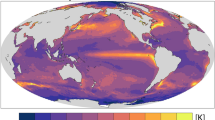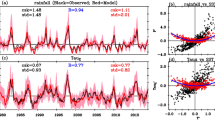Abstract
Many features of the El Niño-Southern Oscillation (ENSO) display significant interdecadal changes. These include general characteristics such as amplitude, period, and developing features, and also nonlinearities, especially the El Niño-La Niña asymmetry. A review of previous studies on the interdecadal changes in the ENSO nonlinearities is provided. In particular, the methods for measuring ENSO nonlinearities, their possible driving mechanisms, and their interdecadal changes are discussed. Two methods for measuring ENSO nonlinearities are introduced; the maximum potential intensity, which refers to the upper and lower bounds of the cold tongue temperature, and the skewness, which represents the asymmetry of a probability density function. For example, positive skewness (a strong El Niño vs. a weak La Niña) of the tropical Pacific sea surface temperature (SST) anomalies is dominant over the eastern tropical Pacific, with an increase seen during recent decades (e.g., 1980–2000). This positive skewness can be understood as a result of several nonlinear processes. These include the warming effect on both El Niño and La Niña by nonlinear dynamic heating (NDH), which intensifies El Niño and suppresses La Niña; the asymmetric negative feedback due to tropical oceanic instability waves, which has a relatively stronger influence on the La Niña event; the nonlinear physics of the ocean mixed layer; the Madden-Julian-Oscillation/Westerly-Wind-Burst and ENSO interaction; the biological-physical feedback process; and the nonlinear responses of the tropical atmospheric convection to El Niño and La Niña conditions. The skewness of the tropical eastern Pacific SST anomalies and the intensities of the above-mentioned mechanisms have both experienced clear decadal changes in a dynamically associated manner. In particular, there is a dynamic linkage between the decadal changes in the El Niño-La Niña asymmetry and those in NDH. This linkage is based on the recent decadal changes in mean climate states, which provided a favorable condition for thermocline feedback rather than for zonal advection feedback, and thus promoted the eastward propagation of the ENSO-related atmospheric and oceanic fields. The eastward propagating ENSO mode easily produces a positive NDH, resulting in asymmetric ENSO events in which El Niño conditions are stronger than La Niña conditions.









Similar content being viewed by others
References
An S-I (2004) Interdecadal changes in the El Niño-La Niña symmetry. Geophys Res Lett 31:L23210. doi:10.1029/2004GL021699
An S-I (2008) Interannual variations of the tropical ocean instability wave and ENSO. J Climate 21:3680–3686
An S-I, Jin F-F (2000) An eigen analysis of the interdecadal changes in the structure and frequency of ENSO mode. Geophys Res Lett 27:2573–2576
An S-I, Jin F-F (2001) Collective role of thermocline and zonal advective feedbacks in the ENSO mode. J Climate 14:3421–3432
An S-I, Jin F-F (2004) Nonlinearity and asymmetry of ENSO. J Climate 17:2399–2412
An S-I, Kang I-S (2000) A further investigation of the recharge oscillator paradigm for ENSO using a simple coupled model with zonal mean and eddy separated. J Climate 13:1987–1993
An S-I, Wang B (2000) Interdecadal change of the structure of the ENSO mode and its impact on the ENSO frequency. J Climate 13:2044–2055
An S-I, Ham Y-G, Kug J-S, Jin F-F, Kang I-S (2005a) El Niño-La Niña asymmetry in the coupled model intercomparison project simulation. J Climate 18:2617–2627
An S-I, Hsieh WW, Jin F-F (2005b) A nonlinear analysis of the ENSO cycle and its interdecadal changes. J. Climate 18:3229–3239
An S-I, Ye Z, Hsieh WW (2006) Changes in the leading ENSO modes associated with the late 1970s climate shift: role of surface zonal current. Geophys Res Lett 33:L14609. doi:10.1029/2006GL026604
An S-I, Kug J-S, Ham Y-G, Kang I-S (2008) Successive modulation of ENSO to the future greenhouse warming. J Climate 21:3–21
Battisti DS, Hirst AC (1989) Interannual variability in a tropical atmosphere-ocean model: influence of the basic state, ocean geometry, and nonlinearity. J Atmos Sci 46:1687–1712
Bjerknes J (1966) A possible response of the atmospheric Hadley circulation to equatorial anomalies of ocean temperature. Tellus 18:820–829
Burgers G, Stephenson DB (1999) The ‘Normality’ of ENSO. Geophys Res Lett 26:1027–1030
Cane MA (1983) Oceanographic events during El Niño. Science 222:1189–1195
Cane MA, Zebiak SE (1985) A theory of El Niño and the Southern Oscillation. Science 228:1084–1087
Cane MA, Zebiak SE, Dolan SC (1986) Experimental forecasts of El Niño. Nature 321:827–832
Carton J, Chepurin G, Cao X, Giese B (2000) A simple ocean data assimilation analysis of the global upper ocean 1950–1995, Part 1: methodology. J Phys Oceanogr 30:294–309
Chang P, Wang B, Li T, Ji L (1994) Interactions between seasonal cycle and the Southern Oscillation: frequency entrainment and chaos in an intermediate coupled ocean-atmosphere model. Geophys Res Lett 21:2817–2820
Eisenman I, Yu L, Tziperman E (2005) Westerly wind bursts: ENSO’s tail rather than the dog? J Climate 18:5224–5238
Fedorove AV, Philander SGH (2001) A stability analysis of tropical ocean-atmosphere interactions: bridging measurements and theory for El Niño. J Climate 14:3086–3101
Galanti E, Tziperman E, Harrison M, Rosati A, Giering R, Sirkes Z (2002) The equatorial thermocline outcropping -– A seasonal control on the tropical Pacific ocean-atmosphere instability strength. J Climate 15:2721–2739
Gu D, Philander SGH (1997) Interdecadal climate fluctuations that depend on exchanges between the tropics and extratropics. Science 275:805–807
Hansen DV, Paul CA (1984) Genesis and effects of long waves in the equatorial Pacific. J Geophys Res 89:10,431–10,440
Hoerling MP, Kumar A, Zhong M (1997) El Niño, La Niña, and the nonlinearity of their teleconnections. J Climate 10:1769–1786
Holland CL Scott RB, An S-I, Taylor FW (2007) Propagating decadal sea surface temperature signal identified in modern proxy records of the tropical Pacific. Climate Dyn 28:163–179
Jin F-F (1996) Tropical ocean-atmosphere interaction, the Pacific cold tongue, and the El Niño - Southern Oscillation. Science 274:76–78
Jin F-F (1997) An equatorial ocean recharge paradigm for ENSO. Part I: conceptual model. J Atmos Sci 54:811–829
Jin F-F, An S-I (1999) Thermocline and zonal advection feedbacks within the equatorial ocean recharge oscillator model for ENSO. Geophys Res Lett 26:2989–2992
Jin F-F, Neelin JD (1993) Modes of interannual tropical ocean-atmosphere interaction - a unified view. Part I: numerical results. J Atmos Sci 50:3477–3502
Jin F-F, Neelin JD, Ghil M (1994) El Niño on the devil’s staircase: annual subharmonic steps to chaos. Science 264:70–72
Jin F-F, An S-I, Timmermann A, Zhao J (2003) Strong El Niño events and nonlinear dynamical heating. Geophys Res Lett 30:1120. doi:10.1029/2002GL016356
Jochum M, Murtugudde R (2004) Internal variability of the tropical Pacific ocean. Geophys Res Lett 31:L14309. doi:10.1029/2004GL020488
Kang I-S, Kug J-S (2002) El Niño and La Niña sea surface temperature anomalies: asymmetric characteristics associated with their wind stress anomalies. J Geophys Res 107(D19):4372–4381
Kessler WS, Kleeman R (2000) Rectification of the Madden-Julian Oscillation into the ENSO cycle. J Climate 13:3560–3575
Kirtman BP, Schopf PS (1998) Decadal variability in ENSO predictability and prediction. J Climate 11:2804–2822
Kleeman R, McCreary JP, Klinger BA (1999) A mechanism for generating ENSO decadal variability. Geophys Res Lett 26:1743–1746
Legeckis R (1977) Long waves in the eastern equatorial Pacific ocean: a view from a geostationary satellite. Science 197:1179–1181
Luo J-J, Yamagata T (2001) Long-term El Niño-southern oscillation (ENSO)-like variation with special emphasis on the South Pacific. J Geophys Res 105:22,211–22,227
McPhaden MJ (1999) The child prodigy of 1997–1998. Nature 398:559–562
Monahan AH, Dai A (2004) The spatial and temporal structure of ENSO nonlinearity. J Climate 17:3026–3036
Neelin JD, Latif M, Jin FF (1994) Dynamics of coupled ocean-atmosphere models: the tropical problem. Annu Rev Fluid Mech 26:617–659
Neelin JD, Battisti D, Hirst AC, Jin FF, Wakata Y, Yamagata T, Zebiak SE (1998) ENSO theory. J Geophys Res C104:14262–14290
Nitta T, Yamada S (1989) Recent warming of tropical sea surface temperature and its relationship to the Northern Hemisphere circulation. J Meteor Soc Japan 67:375–383
Penland C, Sardeshmukh PD (1995) The optimal growth of tropical sea surface temperature anomalies. J Climate 8:1999–2024
Philander SGH (1983) El Niño Southern oscillation phenomena. Nature 302:295–301
Philander SGH (1990) El Niño, La Niña, and the Southern Oscillation. Academic Press, San Diego, CA, 293 pp
Qiao L, Weisberg RH (1998) Tropical instability wave energetics: observations from the tropical instability wave experiment. J Phys Oceanogr 28:345–360
Rasmusson EM, Wallace JM (1983) Meteorological aspects of the El Ninõ/Southern Oscillation. Science 222:1195–1202
Reynolds RW, Smith TM (1994) Improved global sea surface temperature analysis using optimum interpolation. J Climate 7:929–948
Rodgers KB, Friederichs P, Latif M (2004) Tropical Pacific decadal variability and its relation to decadal modulations of ENSO. J Climate 17:3761–3774
Schopf PS, Burgman RJ (2006) A simple mechanism for ENSO residuals and asymmetry. J Climate 19:3167–3179
Schopf PS, Suarez MJ (1988) Vacillations in a coupled ocean-atmosphere model. J Atmos Sci 45:549–566
Smith TM, Reynolds RW (2004) Improved extended reconstruction of SST (1854–1997). J Climate 17:2466–2477
Suarez MJ, Schopf PS (1988) A delayed action oscillator for ENSO. J Atmos Sci 53:2786–2802
Swenson MS, Hansen DV (1999) Tropical Pacific ocean mixed layer heat budget: the Pacific cold tongue. J Phys Oceanogr 29:69–82
Thompson CJ, Battisti DS (2000) A linear stochastic dynamical model of ENSO. Part I: model development. J Climate 14:445–466
Timmermann A, Jin FF (2002a) A nonlinear mechanism for decadal El Niño amplitude changes. Geophys Res Lett 29:1003. doi:10.10129/2001GL013369
Timmermann A, Jin FF (2002b) Phytoplankton influences on tropical climate. Geophys Res Lett 39. doi:10.10129/2002GL15434
Timmermann A, Jin FF, Abshagen J (2003) A nonlinear theory for El Niño bursting. J Atmos Sci 60:152–165
Trenberth KE, Hurrel JW (1994) Decadal atmosphere-ocean variations in the Pacific. Climate Dyn 9:303–319
Tziperman E, Stone L, Cane M, Jarosh H (1994) El Niño chaos: overlapping of resonances between the seasonal cycle and the Pacific ocean-atmosphere oscillator. Science 264:72–74
Vecchi GA, Clement A, Soden BJ (2008) Examining the tropical Pacific’s response to global warming. Eos Trans AGU 89(9):81–83
Vialard J et al (2001) A model study of oceanic mechanisms affecting equatorial Pacific sea surface temperature during the 1997–98 El Niño. J Phys Oceanogr 31:1649–1675
Waliser DE, Graham NE (1993) Convective cloud systems and warm-pool SSTs: coupled interactions and self-regulation. J Geophys Res 98:12881–12893
Wang B (1995) Interdecadal changes in El Niño onset in the last four decades. J Climate 8:267–285
Wang B, An SI (2001) Why the properties of El Niño changed during the late 1970s. Geophys Res Lett 28:3709–3712
Wang B, An SI (2002) A mechanism for decadal changes of ENSO behavior: roles of background wind changes. Climate Dyn 18:475–486
Wang W, McPhaden MJ (2000) The surface-layer heat balance in the equatorial Pacific Ocean. Part II: interannual variability. J Phys Oceanogr 30:2989–3008
Weisberg RH, Weingartner TJ (1988) Instability waves in the equatorial Atlantic Ocean. J Phys Oceanogr 18:1641–1657
White HG (1980) Skewness, kurtosis and extreme values of Northern Hemisphere geopotential heights. Mon Wea Rev 108:1446–1455
Wilson D, Leetmaa A (1988) Acoustic Doppler current profiling in the equatorial Pacific in 1984. J Geophys Res 93:13947–13966
Wu A, Hsieh WW (2003) Nonlinear interdecadal changes of the El Niño-Southern Oscillation. Climate Dyn 21:719–730
Wyrtki K (1985) Water displacements in the Pacific and the genesis of El Niño cycles. J Geophys Res C90:7129–7132
Ye Z, Hsieh WW (2006) The influence of climate regime shift on ENSO. Clim Dynam 26:823–833
Yu JY, Liu WT (2003) A linear relationship between ENSO intensity and tropical instability wave activity in the eastern Pacific Ocean. Geophys Res Lett 30:14,1735. doi:10.1029/2003GL017176
Zebiak SE, Cane M (1987) A model El Niño/Southern Oscillation. Mon Weather Rev 115:2262–2278
Acknowledgments
This research was supported by “National Comprehensive Measures against Climate Change” Program by Ministry of Environment, Korea (Grant No. 1700-1737-322-210-13), and by the Korea Research Foundation Grant funded by the Korean Government (MOEHRD, Basic Research Promotion Fund) (KRF-2007-313-C00784).
Author information
Authors and Affiliations
Corresponding author
Rights and permissions
About this article
Cite this article
An, SI. A review of interdecadal changes in the nonlinearity of the El Niño-Southern Oscillation. Theor Appl Climatol 97, 29–40 (2009). https://doi.org/10.1007/s00704-008-0071-z
Received:
Accepted:
Published:
Issue Date:
DOI: https://doi.org/10.1007/s00704-008-0071-z




